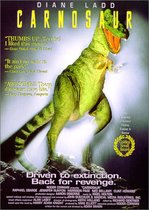Our editor-in-chief Nate Yapp is proud to have contributed to the new book Hidden Horror: A Celebration of 101 Underrated and Overlooked Fright Flicks, edited by Aaron Christensen. Another contributors include Anthony Timpone, B.J. Colangelo, Dave Alexander, Classic-Horror.com's own Robert C. Ring and John W. Bowen. Pick up a copy today from Amazon.com!
Kalifornia (1993)
It's going to be tough to convey the experience of watching director Dominic Sena's film Kalifornia any better, and certainly I can't do so more succinctly, than the following--"If Ingmar Bergman had directed Natural Born Killers."
Reading that catch-phrase and seeing my rating, you might guess that I'm not the biggest fan of Natural Born Killers (NBK). That's not the case. I love Stone's work and NBK is one of my favorite films of all time. But Kalifornia is hardly lacking in quality. It just goes to show that there's more than one way to skin a cat. Or a human, as the case may be.
Maybe comparisons to NBK are shallow. The obvious reasons for the comparison are that Kalifornia is about a serial killer and both it and NBK star Juliette Lewis as a serial killer's woman. And Kalifornia was released before NBK (it beat it by a year). Of course, there's no telling which was first to make the rounds as a script, or an idea at least, in Hollywood. The differences are much deeper, actually, but the comparison serves to show how a similar idea can be turned into two very different, excellent films.
Kalifornia's focus is much tighter. There's an ensemble cast of four -- Brad Pitt, Lewis, Michelle Forbes and an early appearance by David Duchovny. The men have a slight majority of total screentime, but all four actors are remarkably balanced and all turn in stellar performances. There are a few other very brief appearances, but those roles are in the film exclusively to further our quartet's character development and their dilemma. On some accounts that might be a flaw, since the other roles aren't much more than props, or meat to be slaughtered, but it's the only way that Sena can achieve the narrow pithiness along with the growing, anxious claustrophobia that's the heart of this film. In what is surely a literal acknowledgment of this fact, Sena even stocks one scene with mannequins, who serve the same function as the real, ancillary actors did. The mannequins also demonstrate an important fact about Pitt's character's view of the world.
Duchovny plays Brian Kessler, a graduate student in psychology whose main interest is the criminal mind, and specifically, the serial killer mind. His girlfriend, Carrie Laughlin (Forbes), is a photographer in a Mapplethorpe vein. They're living in Kentucky, and not having the greatest career success. Kessler comes up with an idea--drive across the U.S., visiting some of America's most famous murder sites (all fictional as far as I know), to provide material for a book. Laughlin is to shoot the photos. The other point is to end up in "K"alifornia (according to the producers, the spelling difference is only because there was already a 1946 film named California). The only problem is that they're worried about cash. So they decide to share the ride. That ill-fated decision leads them to Early Grayce (Pitt) and Adele Corners (Lewis) -- a couple who could barely be more different than Kessler and Laughlin at first blush.
Kalifornia's impact on the viewer is strong. Grayce is likeable, sympathy-evoking, shocking, repulsive and frightening at various times and often at the same time. Much of this is attributable to Pitt, but the rest of the ensemble create these properties in Grayce as much as Pitt does. It is rare to come across a film where the cast is not only so strong, but works together with a chemistry like a great rock and roll band. Kalifornia is such a film. And usually, those films are straight-ahead dramas. Kalifornia does it in wonderfully bleak serial killer film.
The beginning has shades of a dark, Blade Runner-like atmosphere. As Kalifornia progresses, the look of the film evolves into bright, colorful scenes, but that progression is in reverse to the emotional developments and crises of the film, which begin innocently and end in a quagmire of moral dilemmas and intense tragedy. We can speculate on Sena's motivation for this. I have a number of guesses, all of which may be true or not -- it shows (a) that things are not always as they seem, (b) foreshadowing of the events to come, (c) a profound existential awakening that Kessler experiences as the events unfold, and (d) a gradual explosion of the madness that lies inside Grayce.
Kalifornia never received the attention it deserved, which is especially surprising in view of the cast. It's entertaining, deep, artistic, and no less of a critique of society than any of Stone's work. Although the violence might put some film fans off, it is less intense than the explosion of carnage in Natural Born Killers. For me, each viewing of this film brings out aspects I hadn't noticed before, but everyone should check out this film at least once.
Trivia:
The difference between the R and NC-17 minute version is about a minute.








